Artist Shōichi Hasegawa
Shōichi Hasegawa, a Japanese painter and graphic designer residing in Paris, began his artistic journey after joining the Japanese Hasegawa Post Office in Yaizu. While working there, he discovered his passion for drawing and decided to pursue an apprenticeship as a painter. From 1945 to 1951, he underwent training and studies under the guidance of Yoshinari Koga, a locally renowned artist known for realistic portraits and landscapes. Hasegawa later moved to Tokyo and attended the Koguga Academy to further his studies in painting.
During his time in Tokyo, Hasegawa was greatly influenced by Tasuku Kasukabe, a notable watercolorist, who introduced him to an association of watercolorists. Hasegawa participated in their exhibitions and found inspiration from their work. Another significant influence on Hasegawa's artistic development, both technically and conceptually, was his acquaintance with Kawaguchi Kigau, a renowned Japanese painter who had been involved in the research of Cubism and Surrealism in 1920s Paris.
In 1961, Hasegawa and his wife relocated to Paris to learn the art of printmaking, a technique not widely used in Japan at the time. He became a student at the Hayter studio, which was considered the birthplace of printmaking for artists in France. In Paris, Hasegawa's artistic style became increasingly influenced by European art, particularly evident in his works' connection to Paul Klee. Additionally, his watercolors, characterized by their transparency, density, and symbolic encoding, bore the influence of Mark Rothko's lyrical abstraction. Hasegawa employed soft pastel palettes and layered textures to reflect the meticulous process of creating his artworks.
Apart from color prints, Hasegawa's body of work includes watercolors and oils, where delicately shaded color areas harmonize with subtle lines, often hinting at figurative elements. The coloring often creates an ethereal and undefined sense of space. His Japanese heritage is visible in his skillful use of empty space, a significant aspect of his image compositions. Hasegawa's contribution to contemporary Japanese art has been widely recognized, and he has participated in numerous solo and group exhibitions both in Japan and abroad. His artworks can be found in prestigious collections worldwide.
Hasegawa's unique artistic style, combining abstraction with elements of nature, has made a lasting impact on the history of art in Japan and has served as inspiration for many artists and admirers across the globe. Today, his paintings and delicate prints are housed in esteemed institutions such as the Bibliothèque nationale in Paris, the Museum of Modern Art in New York, the Victoria and Albert Museum in London, the Norrköpings Museum of Art, and the Museum Fuji in Tokyo. Hasegawa currently resides and works in Val-d'Oise, France, the same location where the renowned Impressionist master Claude Monet once lived. In addition to his artistic endeavors, Hasegawa also served as a professor at Musashino University of Fine Arts, where he trained and influenced multiple generations of artists.
Why invest in Shōichi Hasegawa?
1. A unique artistic path: Hasegawa's artistic journey began from humble beginnings as a radio operator, and his subsequent transition to painting shows a compelling narrative that adds depth and meaning to his work.
2. Diverse training and influences: Hasegawa underwent extensive training under Yoshinari Koga and Tasuku Kasukabe, enriched by Parisian training and the influences of Klee and Rothko.
3. International perspective: Moving to Paris and studying at the Hayter studio provided Hasegawa with exposure to European art and the opportunity to fuse his Japanese heritage with Western artistic influences, resulting in a unique fusion of styles and ideas.
4. Technical mastery: Hasegawa's mastery of several techniques, including printmaking, watercolors, and oils, demonstrates his versatility as an artist and showcases a wide range of artistic expression.
5. Symbolic and ethereal imagery: Hasegawa's works are characterized by transparency, density, and encoded symbolic elements, creating a captivating and ethereal quality that engages viewers on multiple levels.
6. Skillful use of color and texture: The artist's use of muted pastel color palettes and layered textures adds depth and dimension to his works, reflecting the meticulous process and emphasizing the tactile nature of his art.
7. Delicate figurative hints: Hasegawa's paintings and prints often incorporate subtle figurative elements, inviting viewers to explore the intersection between abstraction and representation, blurring the boundaries between the two.
8. Strong artistic legacy: Hasegawa's significant contributions to contemporary Japanese art have earned him the recognition and respect of the art community, making his works a valuable addition to any art collection.
9. Presence in prestigious collections: Hasegawa's works can be found in prestigious institutions around the world, such as the Bibliothèque nationale in Paris, the Museum of Modern Art in New York, and the Victoria and Albert Museum in London, testifying to their cultural value and significance.
10. Influence and inspiration: Hasegawa's unique artistic style, combining abstraction with elements of nature, has left a lasting impact on art history in Japan, inspiring successive generations of artists and earning him a place of admiration and influence in the art world.
Morning Light
"Morning Light" is a captivating artwork that skillfully captures the essence of the morning atmosphere through poetic composition. The print employs delicate lines and abstract shapes to convey the ephemeral beauty and serene ambiance characteristic of this special time of day.
The print's tones and textures work harmoniously to create a gentle and understated atmosphere. Hasegawa strategically utilizes subtle contrasts between areas of light and shadow, imbuing the artwork with a sense of depth and dimension.
Renowned for his mastery of printmaking, Shōichi Hasegawa's expertise shines through in "Morning Light." The artwork exemplifies his ability to encapsulate the fleeting nature of a particular moment and translate it into a visually captivating composition—a signature trait of his artistic style.
"Morning Light" by Shōichi Hasegawa stands as a remarkable representation of the artist's unique artistic vision and his talent for crafting timeless works of art. His adeptness in printmaking and his keen sensitivity to light and mood combine to make this artwork a cherished addition to Hasegawa's artistic oeuvre.
From a stylistic point of view, "Morning Light" is a representation of the artist's distinct stylistic elements, encapsulating the link between Eastern and Western sensibilities. This duality is evident throughout Hasegawa's work, where his symbolic and enigmatic writing interacts with suggested colors and subtle hues, creating transparent and harmonious compositions.
Hasegawa's artistic exploration in bridging the gap between East and West is exemplified in "Morning Light," definitely the result of the artist's time spent in Paris. This move marked a significant phase in his graphic expression, in which he skillfully adapted to the printmaking techniques he had discovered three decades earlier at the Hayter studio. Through a meticulous process that combined the traditional methods of etching and aquatinting, Hasegawa's artistic alchemy involved the interaction of paints, essences and acids, resulting in overlapping inks that produced secondary or tertiary tones. These techniques also veiled the sheen of the paper around acid-etched lines, creating a sculpted relief on the print.
In this context, the colors used in Hasegawa's works possess a wide range of values and a delicate transparency, capturing the ephemeral nature of a fleeting moment. As a result, the viewer's gaze is constantly engrossed by the play of light, sometimes resting on the depiction of natural, architectural or fantastical elements, and then hovering to discover a myriad of fauna or abstract signs. Thus, "Morning Light" and other engravings by Hasegawa unveil a multitude of intricate details that evoke a dream city residing deep in our consciousness.
In addition to the artistic influence of evocation and abstraction, Hasegawa's graphic creations draw inspiration from a technical arpeggio, a harmonious interplay of techniques. However, this technical skill is constantly challenged to authentically convey the artist's inner fascination. As a result, Hasegawa's etchings reflect a poetics that emerges from a blend of Orientalist atmosphere and Western modernism. Each energy-charged print witnesses unprecedented renewal, resonates with a sense of happiness and serves as a testimony to an active spiritual life.
In sum, Hasegawa's work, exemplified by "Morning Light," displays his unique artistic vision that harmoniously combines Eastern and Western influences. Through the skillful use of symbolism, transparency and technical mastery, Hasegawa's prints evoke a deep emotional response and represent a constant quest for renewal and happiness.
Why invest in "Morning Light"?
1. Captivating Essence: The artwork skillfully captures the essence of the morning atmosphere, creating a captivating and evocative composition that resonates with viewers.
2. Poetic Composition: "Morning Light" embodies a poetic composition that conveys the ephemeral beauty and serene ambiance characteristic of the early hours of the day.
3. Delicate Lines and Abstract Shapes: The print employs delicate lines and abstract shapes, showcasing Hasegawa's artistic technique and adding depth and visual interest to the artwork.
4. Gentle and Understated Atmosphere: The tones and textures used in the print work harmoniously to create a gentle and understated atmosphere, enhancing the overall aesthetic appeal.
5. Skillful Use of Light and Shadow: Hasegawa's strategic use of subtle contrasts between areas of light and shadow infuses the artwork with a sense of depth and dimension, adding visual richness to the composition.
6. Mastery of Printmaking: As a renowned master of printmaking, Hasegawa's expertise shines through in "Morning Light," reflecting his technical skill and artistic proficiency in this medium.
7. Timeless Appeal: The artwork's ability to capture the fleeting nature of a particular moment and translate it into a visually captivating composition ensures its timeless appeal, making it a valuable addition to any art collection.
8. Unique Artistic Vision: "Morning Light" exemplifies. Shōichi Hasegawa's unique artistic vision, showcasing his ability to blend Eastern and Western influences in a harmonious and distinctive manner.
9. Cultural Fusion: The artwork represents the artist's exploration of bridging the gap between different cultural sensibilities, offering a compelling fusion of Eastern and Western artistic elements.
10. Emotional and Spiritual Resonance: Hasegawa's prints, including "Morning Light," evoke a deep emotional response and reflect a quest for renewal, happiness, and an active spiritual life, making them a meaningful investment for art enthusiasts.




 Olimpia Gaia Martinelli
Olimpia Gaia Martinelli

